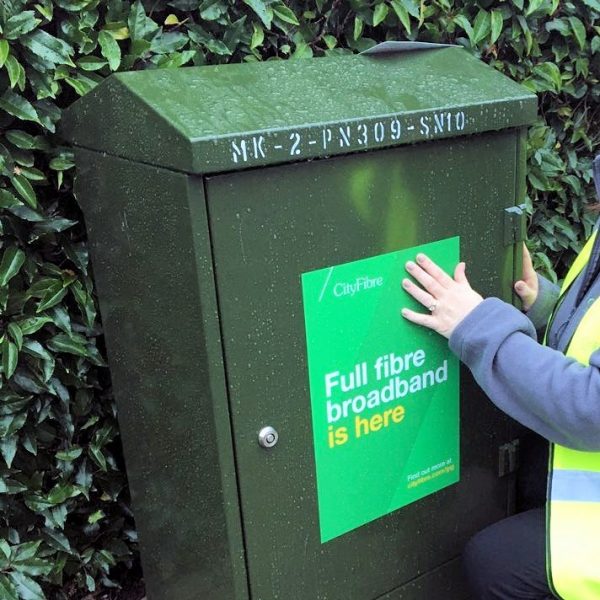BT Fail to Get CityFibre Ad Banned Over Full Fibre Availability Complaint UPDATE

The Advertising Standards Authority (ASA) has declined to uphold a complaint against one of CityFibre’s direct mailing adverts for their new UK FTTP broadband network. The complaint was lodged by the BT Group after they suggested it “misleadingly implied there was no existing full fibre broadband at the address.”
The ad itself was one of CityFibre’s normal leaflets, which merely acted to notify homeowners (i.e. usually those within their targeted build areas) that they were “going to be building a brand new full fibre network in your area and wanted to let you know what’s going to happen“.
CityFibre said the direct mailing was sent to a resident in a location where they were building a new full fibre network, that was being funded using state aid from the UK government’s Project Gigabit programme. However, BT’s complaint arose from the fact that the property that had received the ad subject to the complaint, and the areas surrounding the address, did in fact have access to an existing full fibre network via Openreach.
Advertisement
The complaint is an interesting one because it’s not uncommon for such mailings to reach slightly outside their target areas (i.e. it can be difficult to be perfectly precise with these things and build plans may also change or be delayed). Put another way, any ruling in this area by the ASA could stand to impact a much larger number of network operators. But the ASA ultimately chose not to uphold BT’s complaint.
ASA Ruling (REF: A24-1271770 CityFibre Holdings Ltd)
Nevertheless, we considered the specific content of the ad and whether or not it stated or implied that no existing full fibre network was available at the property. The ad did not state or imply that their upcoming network was the only full fibre network or that other providers did not operate their own full fibre network in the area and, as such, we considered consumers were unlikely to take that impression from the claims when read in context. We therefore concluded that the ad was not misleading.
We don’t usually write about complaints that are not upheld, but this one touched on a subject of some interest. In addition, the ASA were only able to assess it under their older rules (the ad itself was seen when those were still in force), rather than the newer ‘Unfair Commercial Practices’ provisions in the Digital Markets, Competition and Consumers Act 2024 (DMCCA). But it’s unclear whether using the newer rules would have made a difference.
UPDATE 3:49pm
A spokesperson for EE has informed us that the ASA did uphold a second part of their complaint, although this was resolved “informally” (i.e. when the advertiser agrees to quickly remove or amend a claim – a minor infraction). Sadly, we don’t usually get detailed visibility of informally resolved issues. This concerned the envelope that CityFibre’s mailer was received in, which didn’t make clear it was advertising.
Advertisement
According to EE, the ASA upheld part 1 of their complaint, because it is said to have appeared to be an official government communication rather than marketing material. This point was resolved informally after CityFibre acknowledged the issue during the ASA’s investigation.
An EE spokesperson said:
“We disagree with the ASA’s interpretation of City Fibre’s claims in the mailing. However, we welcome their decision to uphold against the claims made on the envelope because it appeared to be an official government communication rather than marketing material. This point was resolved informally after CityFibre acknowledged the envelope was misleading during the investigation.”
Mark is a professional technology writer, IT consultant and computer engineer from Dorset (England), he also founded ISPreview in 1999 and enjoys analysing the latest telecoms and broadband developments. Find me on X (Twitter), Mastodon, Facebook, BlueSky, Threads.net and Linkedin.
« CEO of Broadband Operator F&W Networks Eyes Return to FTTP Build























































So the leaflet said, “going to be building a brand-new full fibre network in your area and wanted to let you know what’s going to happen“ So that is correct, they are building a new network, If they said, they would be the only one, then that would be a different thing.
I bet the leaflet went to someone who works for BT.
The bigger question is why an altnet is receiving taxpayer subsidy when another operator already provides equivalent service (symmetric / XGS obsessives need not reply). What is the justification for this?
I’m aware of MDUs where CityFibre and their partners seem adamant that they cover the building & have sent out mailings accordingly, but there is no evidence that they actually do. I’d hope they haven’t just assumed it’s in coverage because the rest of the street is.
Good point Ivor, obvious misuse of taxpayers money.
Main potential benefit for consumers may be lower prices compared to OR, at least that’s one reason why I’d welcome a half decent alt-net to my area that isn’t VM.
Although I’m sure those who live in an area without FTTP who desire it will be frustrated by this.
Or BT receiving various state funded project money for areas covered by Altnet or BT picked in favour over others for projects. Cuts both ways BT Ivor 🙂
This is an excellent ruling though, and a punch in the face to a bumbling telco. The days when FTTC was labelled on cabinet leaflets and the old Infinity advert campaign by BT in the FTTC days, pretending to be full fibre, when it was still a good amount of sweaty copper…..
The government do market research 3-4 times a year to see where they need to subsidise. If companies don’t provide accurate information or change their plans with little notice, then there is going to be a small degree of overbuild. Then trying to vary contracts of this size takes a long time so unfortunately a bit of this seems inevitable.
I assume they were given the lot for a large area, and then used their own funding to “piggy back” off of work that they were already doing to fund some additional build… e.g. if they’re getting state aid to build to rural areas surrounding a town, then it probably makes sense for them to use private funding to build to the town itself.
An alternative explaination might be that CityFibre were given the lot and then a small number of households ordered FTTPoD.
There are probably other explainations too.
Either Openreach decided on it last minute and by the time DCMS were aware it was too late or they failed to notify of their plans in a timely fashion.
This can only be minimised, not entirely eliminated. Government rely on network operators keeping them informed. At some point in time the intervention area for a contract has to be set.
@anonymous – what’s the problem with BT winning contracts?
Examples please for ‘BT receiving various state funded project money for areas covered by Altnet’.
The Netomnia CEO brought this up in a video with the Zen owner, he made the point that the government has been doing these subsidised rollouts too quickly and easily without waiting first for commercial rollout to finish. As such there is areas with these schemes getting multiple coverage.
“doing these subsidised rollouts too quickly and easily”
It’s better than what government normally does which is to tie everything up in red tape forever and a day until everyone is happy, which, of course, they never are.
Better to err on the side of getting things done. If a few streets get subsidised funding when they were commercially viable then so be it. I’m sure the extra spending is nothing compared to the alternate. C.f with HS2 billions upon billions spent on literally nothing. If they’ve just got on and built it it would be done by now at a massively lower cost.
Try telling the people waiting for broadband that it’s too quick! Chelot just trying to ring fence future customers.
It is strange, but BT have had more than enough taxpayers’ money over the years. Maybe they think Openreach need competition. I would have preferred the money going to put networks in places where the chance of fibre going is slim, or at least for a few more years.
Maybe BT had sour grapes seeing that a potential customer would have more then one option available to them.
Having been messed around by Openreach & a BT owned ISP recently with a FTTP upgrade I’m glad there is other options out there spreading across the UK.
While I have had problems with BT, mainly customer service and hardware problems, which is why I told them to stick their broadband where the sun don’t shine, Openreach was pretty good when I had problems, well the people that come here to try to fix the problem were.
My views of how Openreach is run and that it should not be a private company still stands and I still think they are years behind other networks, but give credit where it is due.
Sadly they could not fix the problem and we came to a workaround and then at some point it either sorted itself out or they did something at the cabinet. Irrelevant now
“Main potential benefit for consumers may be lower prices compared to OR, at least that’s one reason why I’d welcome a half decent alt-net to my area that isn’t VM.”
But not at the taxpayer’s expense. Subsidies are intended for locations with no fibre options (and no likelihood of obtaining them on a commercial basis in any reasonable timeframe), not to give one company a leg up over another.
“The government do market research 3-4 times a year to see where they need to subsidise. If companies don’t provide accurate information or change their plans with little notice, then there is going to be a small degree of overbuild. ”
Are these areas not subsidised on the basis that no one else (ie Openreach) has no plans to do so for several years?
“Or BT receiving various state funded project money for areas covered by Altnet or BT picked in favour over others for projects. ”
Openreach wouldn’t get subsidies if there is an equivalent service available, nor should they. That won’t stop them overbuilding altnets eventually as part of their commercial rollout however.
“The days when FTTC was labelled on cabinet leaflets and the old Infinity advert campaign by BT in the FTTC days, pretending to be full fibre, when it was still a good amount of sweaty copper…..”
They never called FTTC “full fibre”. Direct your anger at the blessed Virgin Media whose advertising has previously used the terms “fibre broadband” next to a picture of a copper coaxial cable, and who started this whole thing at a time when BT themselves were still trialing VDSL as something they might possibly do in the future.
I suppose the idea that this is a commercial extension to a subsidised rollout is plausible, though I’d wonder whether that invalidates the case for subsidies altogether and there should be a clawback mechanism for that.
I’d be curious to know how BT found out about it for one… But also, about a decade ago I used to get Virgin Media postal ads and that side of town has no cable service, so it’s always been an issue. Sounds like BT still need to grow up.
Maybe if BT actually built all their FTTP out rather than worrying what the competition are doing…
Plenty fibre sitting around in the UK that’s, for reasons unknown to me, been built from the customer backwards and the funding ran out so never been finished.
Horrible company to work for, ran by complete buffoons that like to micromanage their staff. Plenty of two faced brown nosing sycophants trying to climb over each other to climb the corporate ladder as well.
I doubt the people who filed the ASA complaint were pulling themselves away from their day job building FTTP.
Awww bless is BT getting worried. The city fibre network smashed BT. Better speeds better pings. I love my 2.5g XGS PON.
@The Facts – All the info you need is on the news archive on this site over the years…..
When will you BT fan boys wake up and realise that BT are poor outside of their core network (i.e. to Residential).
They’ve taken so long to deploy anything it becomes out of date, like their legacy GPON even. Meanwhile, others are keeping up to date, even Virgin Media with Nexfibre network and eventually by 2028 the HFC/RFoG areas will be XGS-PON capable.
The BT fan boys obviously worried, because of all the defence put up with every excuse under the sun as to why BT sweated copper for so long and told us how wonderful FTTC was and that it was the fastest residential customers needed. ONLY competition changed their mind, they were forced to change, and not because they wanted to. ANd they still deply GPON as of today, criminal.
You seen beyond obsessed with this.
It’s pretty tiresome reading this on every remotely related article. The point about the technical debt got completely lost with the repetition, fixation thinking most people care about GPON versus XGSPON when most just want ‘WiFi’ and are buying 150 and under, and the ad hominem attacks on anyone who disagrees. It’s just weird when week after week, month after month you’re writing the same thing for no constructive reason.
The fibre in the ground isn’t going to go obsolete. It’s a well constructed FTTP network with a 32:1 maximum split ratio. Upgrading the actives is pretty painless. The exchanges are either ready for new XGSPON chassis via co-existence elements that are already there or are OLTs with combo ports.
Tons of people still use FTTC, you think all the GPON will be gone in 5 years? It’ll be sitting there serving people on budget tiers for ages. It’s legacy kit for sure but it’s not obsolete, most of the world’s FTTP by a mile is GPON.
Openreach are working through OLT and ONT inventory still. They probably signed the contracts they’re being supplied under years ago. They don’t go to the local corner shop for their ONTs they bought millions from manufacturers. They don’t go on BroadbandBuyer for their OLTs.
You keep going on about how scared Openreach are of altnets (it’s short for alternative networks, a contraction not an acronym so no capitalisation just FYI) how far behind with the tech they are and how they refuse to sell XGSPON. Not exactly consistent with being terrified if it’s anywhere near as big a deal as you think it is, is it?
I love that Openreach are sticking with GPON. I want altnets to do well and am happy with every advantage BT give them. No idea why you’re so bitter about it unless you’re stuck in an Openreach FTTP only property.
You’re apparently a huge fan of altnets so should be celebrating Openreach not wanting to be technically competitive.
On the advertising companies complain about each other to the ASA all the time. That’s life. I’m not a fan of the complaining to the ASA but it’s reality,
@PolishPoler – “Upgrading the actives is pretty painless.” – No, it’s NOT. This is BT. It means years of trials and slow roll outs and asking for government incentives! I’m sick of waiting for the ultra slow BT to decide everything in this country. Hell, some of the ALTNETS will be on 50PON by end of this year!!!
As a customer, I and many others want symmetric. Fat chance under useless BT. They could have even done it with GPON, or at least half the download speed, but no, in their infinite wisdom they hold people back.
All the rubbish about broadbandbuyer and corner shops is just that. Netomnia and others work direct with ADTRAN and NOKIA for example and they have already done their research with 50PON and looking to deploy by end of this year. BT cant even get their act together to get to XGS-PON. Embarrassingly for them, even Virgin Media under NexFibre are XGS-PON and will be on their coax network areas by 2028. BT will still be GPON by 2028. VM also don’t buy from a corner shop, so stop the nonsense statements.
Relative to deploying the fibre network, yes, upgrading actives is a really minor thing.
The rest of your post just emphasises that you haven’t a clue what you’re talking about. Rambling nonsense.
@BT Ivor, here is a link of BT’s own FTTC cabinet saying Fibre broadband. Enjoy! Look in google for lots more. No mention of Hybrid Fibre or similar. As for VM using fibre term prior to NexFibre, they were certainly closer to it than BT, as they used coax which can carry 10gbs speed and suffers less interference than telephone wire used by BT. Also DocSis 3.1 can do multi gig – just in the UK VM didn’t optimise network segments as they decided to do full fibre upgrade instead under Project Mustang. So they were always closer to “fibre” expected speeds than FTTC could ever be.
https://www.ispreview.co.uk/index.php/2019/12/identifying-bt-and-virgin-medias-uk-broadband-street-furniture-2019.html
To be fair to Ivor, he said full fibre, and he is correct, there is nothing on the cabinets saying full fibre. But Bt knew that it would get some people thinking they are getting fibre, and that is one thing that have bitten them on the back side.
You be surprised how many people, on FTTC, think they have fibre broadband and see no reason to change.
It is getting better as more information goes out, and I have also told a few people who think they are on fibre what they are really on. But even so it is difficult to get some people to change.
“were certainly closer to it than BT, ”
Technically the fibre to copper conversion happens closer to homes on Openreach’s network. Openreach also has a more seamless upgrade path to FTTP whereas Virgin are essentially replacing it all.
Virgin used to be plagued with congestion issues (remember the dreaded STM?) that Openreach has never had, including on VDSL. IIRC for quite some time VDSL offered faster upload speeds too.
“which can carry 10gbs speed and suffers less interference than telephone wire used by BT.”
But it doesn’t, and it won’t without serious investment (at which point you might as well go FTTH, which is what VM is doing). FDX DOCSIS is arguably the cable industry equivalent of G.fast.
“So they were always closer to “fibre” expected speeds than FTTC could ever be.”
What is a “fibre expected speed”? If I have a 40Mbit FTTP service, is that not “fibre speed”?
“You be surprised how many people, on FTTC, think they have fibre broadband and see no reason to change.”
Why would they change if it does what they want at a price they consider acceptable?
One possibility to consider here is that there are a number of areas where there are already other providers, but they border areas or housing estates that have no coverage.
The area with no coverage gets service installed with a subsidy, and because shared elements such as the backhaul are now present in the locality, it suddenly makes commercial sense to be able to do a bit of overbuild to expand their footprint where it would otherwise not have been viable before.
Whether in those situations the network operator should be required to pay back a portion of the cost of the “enabling aspect” is a worthwhile debate, though I suspect that would then make these subsidised builds far less attractive, thus defeating the purpose.